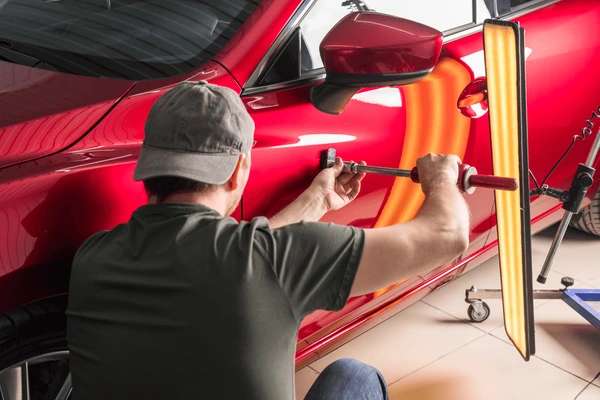Beneath the Surface: How Professional Car Dent Repair Can Save You Thousands
Car dent repair might seem like a cosmetic indulgence, an aesthetic concern that can be indefinitely postponed in the hierarchy of automotive maintenance. Yet beneath the surface of these seemingly innocuous imperfections lies a narrative of metal fatigue, paint degradation, and value depreciation that unfolds with the quiet persistence of a chronic illness.
The Anatomy of a Dent
When we examine a dent, we are observing more than just a depression in metal. We are witnessing the confluence of physics and material science—a testament to the laws of energy conservation where kinetic force has been transferred into the deformation of a once-smooth surface. Like the human body’s response to trauma, the metal retains a memory of this impact, creating tension within its microscopic structure.
The modern automobile body panel consists of several layers: the base metal (typically steel, aluminium, or composite material), primer, paint, and clear coat. Each layer serves a specific purpose in the complex ecosystem of your vehicle’s exterior. When a dent occurs, this delicate arrangement is compromised, even if the naked eye detects no paint damage.
The Progressive Nature of Untreated Dents
Much like certain pathologies in medicine, untreated dents tend to deteriorate over time. Consider the following progression:
- Initial impact phase: The dent appears. Paint may seem intact.
- Microscopic cracking phase: Invisible to the naked eye, the clear coat and paint layers develop microfractures.
- Environmental infiltration phase: Moisture, road salt, and pollutants begin to access the base metal through these microscopic pathways.
- Oxidation phase: The metal begins to oxidise, forming rust that expands and further compromises the structural integrity.
- Cosmetic failure phase: Visible paint bubbling, flaking, and rust formation occur.
“The deterioration of untreated dents follows a predictable pathophysiology that accelerates exponentially once environmental factors breach the protective layers,” notes a Singapore car dent repair specialist with over two decades of experience.
The Economics of Delayed Intervention
There exists a curious inverse relationship between the time elapsed since dent formation and the cost-effectiveness of repair. A prompt intervention often preserves the original paint, allowing for paintless dent repair (PDR)—a technique that is both economical and minimally invasive.
Delay the repair, and you enter a realm of exponentially increasing costs:
- Paintless dent repair: £75-£200 (small to medium dents)
- Traditional body repair with painting: £300-£800
- Panel replacement: £500-£2,000+
- Rust treatment and extensive restoration: £1,000-£3,000+
“A stitch in time saves nine” has perhaps never been more applicable than in the context of automotive bodywork restoration.
Modern Methodologies in Dent Correction
The evolution of car dent repair methodologies parallels the advancement of surgical techniques—moving from highly invasive procedures toward minimally invasive approaches with faster recovery times.
Paintless Dent Repair: The Microsurgery of Automotive Restoration
This technique, which gained prominence in the 1980s but has roots dating back to the 1930s, utilises specialised tools to massage the metal back into its original position without disturbing the paint. The process requires:
- Careful assessment of the dent’s geometry and accessibility
- Strategic placement of specialised tools behind the panel
- Precise application of pressure to gradually reshape the metal
- Final refinement to ensure perfect contour restoration
“The artistry in paintless dent repair lies in understanding the memory of metal—how it wants to return to its original form if guided with the right pressure at the correct points,” explains a veteran PDR practitioner from Singapore’s automotive restoration community.
Traditional Body Repair: When Reconstruction Becomes Necessary
For dents with paint damage or those too severe for PDR, traditional methods involve:
- Careful pulling of the dent using specialised equipment
- Filling remaining imperfections with body filler
- Sanding to achieve a smooth surface
- Priming, painting, and clear coating to restore the factory finish
The Psychological Dimension
There exists an often overlooked psychological component to driving a vehicle bearing visible damage. Much like a person who becomes self-conscious about a physical imperfection, owners of dented vehicles report a diminished sense of pride and satisfaction in their automobiles.
This phenomenon extends beyond mere vanity. A well-maintained vehicle reflects attention to detail and conscientious ownership—qualities that have tangible benefits in both personal and professional spheres.
Prevention: The Ultimate Cure
As in medicine, prevention remains superior to treatment. Consider:
- Parking strategically to minimise exposure to shopping trolleys and carelessly opened doors
- Maintaining proper following distance to reduce the risk of road debris impact
- Applying protective films to vulnerable areas
- Garage parking whenever possible to reduce exposure to environmental hazards
Conclusion
The decision to repair or ignore a car dent transcends simple aesthetics—it represents a choice between proactive maintenance and reactive restoration. Like many health conditions that begin with subtle symptoms, the consequences of neglect often manifest only when intervention becomes more complex and costly.
As vehicles increasingly become expressions of our identities and significant financial investments, perhaps we would do well to extend the same diligence to their care as we do to our physical wellbeing. The science and craftsmanship behind modern car dent repair offer solutions that restore not just appearance, but also integrity and value to these mechanical companions that faithfully transport us through our daily lives.





